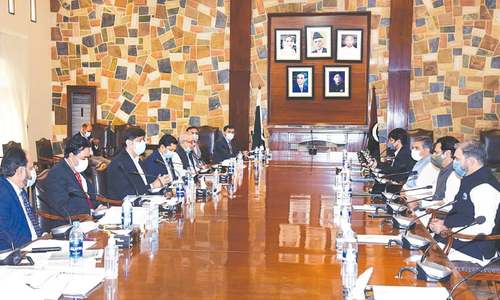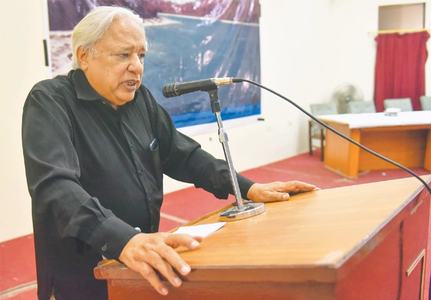All three barrages of Sindh face closure at different periods from December onwards each year for annual maintenance. During the closure, a cry among farmers was seen about the desilting of channels including branches that feed their agricultural lands across Sindh. Managements of three barrages, however, explain that such closure is usually meant for regular refurbishment including oiling and greasing of barrage structure and head regulators of off-taking canals, 14 in all at Guddu, Sukkur and Kotri barrages, out of funds meant for maintenance and repairs (M&R) expenditures.
Sindh has a contiguous irrigation system built in the colonial era. Over the years due to deferred repairs, it has faced serious technical problems of engineering that contribute to the injudicious distribution of irrigation. Eventually, the outcry about the nonavailability of water flows in tail-end areas of almost every main canal of the barrage was seen.
Among growers, the annual closure of barrages is normally considered as an exercise for the desilting of main canals and their downstream systems. Every farmer, big or small, now demands desilting of the channel in his area. Tail-ends of all major canals face water supply issues. This has also promoted direct outlets (DOs) culture which is again a menace for the irrigation system. Supreme Court has ruled against it as it denies tail-end farmers their right of water share whilst upper riparian gets over and above allocated share.
Sindh being at the tail-end of the Indus river system is always crying hoarse against the non-supply of its due share of water— delayed maintenance of the irrigation network makes matters worse for growers
Sindh irrigation authorities strongly disagree with this contention of growers. They say it is financially and technically not possible to carry out the desilting of every canal and its connected system every year. Growers leaders like Nawab Zubair Talpur believe that desilting works were carried out only on paper and practically no measures were taken for ensuring the upkeep of the canals’ system thus water shortage.
“Desilting of every canal is simply not possible and it is not technically recommended either,” argues Kotri barrage chief engineer Haji Khan Jamali. The closure is for maintenance of barrage structure and head regulators of perennial and non-perennial off-taking canals of any barrage.
As per standard operating procedures (SOPs), he explained, if a canal had been desilted it could not be chosen for desilting again the next year. According to him, desilting is a big exercise in a canal and it involves plenty of funds that are not usually unavailable under the M&R head. “Any such scheme of desilting of a branch of minor is to become part of the annual development plan (ADP) of the provincial government,” he remarked. He claimed that the desilting of the main canal could not be done technically because they were designed in a way that stops silt accumulation in its bed.
Figures available with the Sindh irrigation department put the total length of the provincial irrigation network of three barrages at 12,360.65 miles or 19,888.29 km. Its break-up shows that Guddu barrage, first over Indus in Sindh, has a total length of 3922.28 miles network of Ghotki feeder, Begari Sindh and Desert Pat Feeders; 5455.64 miles of Sukkur barrage network involving its seven main canals. Kotri barrage has a total length of 2982.73 miles of Akram Wah, Fuleli, Pinyari and Kalri Baghar canals.
Of Sindh’s 14-main canals, Sukkur barrage’s Rohri canal was the only off-taking perennial canal whose around 20km or 12.14 miles length was lined in 2015-16 in Benazirabad at a cost of Rs10.51 billion in two phases. “Third phase of the lining of the canal is in process of procedural requirements,” confirmed Rohri canal Superintending Engineer, Zaheer Memon. Some branches and minors of the Nara canal system including West Jamrao, Heeral, Noor Wah, Naukot branch, Chor Wah, Gajar etc were also lined for water-saving purposes.
The irrigation system of Sindh — considerably old — has not witnessed the required investment for financial constraints and the resultant delay in the upkeep of the system has justifiably led to farmers’ complaints and cries about official neglect of channels’ maintenance. In every government, influential landowners have been able to get their canals desilted. Not only this they were also able to get water flows for their lands at the cost of other tail-end users, small- and medium-size farmers.
“Irrigation department is the only government’s entity that spends budget over and above its allocated funds while other departments report under-utilisation of funds earmarked in the budget book,” argued Sindh Chamber of Agriculture (SCA) vice president Nabi Bux Sathio. He said that the irrigation department could at least publicise their works to be carried out during the annual closure exercise so that growers could also check them adding that there were many regulators of channels and minors that face rusting but the department remained least bothered about it. “We agree that every canal can’t desilted. But at least regulators of branches and minors can be refurbished,” he says.
A seasoned irrigation official opined manual desilting was recommended wherever necessary but ever since the introduction of excavators 2000 onwards, growers started demanding it after water shortage became pronounced in Sindh’s agricultural landscape. Until the 90s, manual labour used to be engaged in desilting and only an acceptable quantum of silt was removed from the beds. The use of excavators, however, in de-silting in any branch or minor has damaged the water regime.
“Excavators go deeper in a branch or minor while removing silt, widening the section and badly affecting flows that otherwise reach lands. It breaks the velocity of water in the system through the mismatch of bed levels of canal and agricultural land to be fed through any canal system,” he said. Resultantly, he said, everyone started using machines for lifting water which led to an outcry about the nonavailability of water for downstream water users.
The irrigation system in Sindh works under a dual administrative hierarchy — the provincial irrigation department and Sindh Irrigation and Drainage Authority. The latter which seeks to promote a participatory irrigation system also controls three main canals, one each at three barrages of Sindh. They include Ghotki feeder of Guddu barrage, Nara canal of Sukkur, Akram Wah and New Phulelli of Kotri barrage. A former Nara canal director Mansoor Memon pointed out that in 2012, many channels canals’ specifications were restored to a great extent so that they carry as per their design and this helped farmers to avoid using lift machines.
According to incumbent Nara canal director Javed Hakeem Memon, currently, Rs14 million has been sought for desilting of Khipro canal for which approval is awaited and added that this channel distributes water to areas in Sanghar and Mirpurkhas districts. “We are currently carrying out desilting exercise in Mithrao canal from Bareji to Darelo regulators which involves an expenditure of Rs80m,” he disclosed.
Sindh being the tail-end province of the Indus river system is always crying hoarse against the non-supply of its due share of water in terms of interprovincial water distribution regulated by the Indus River System Authority. Delayed maintenance of irrigation network makes matters worse for growers, indeed.
Published in Dawn, The Business and Finance Weekly, January 17th, 2022














































